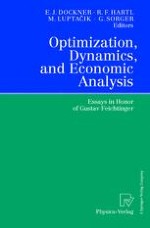2000 | OriginalPaper | Buchkapitel
Quantifying Vicious Circle Dynamics: The PEDA Model for Population, Environment, Development and Agriculture in African Countries
verfasst von : Wolfgang Lutz, Sergei Scherbov
Erschienen in: Optimization, Dynamics, and Economic Analysis
Verlag: Physica-Verlag HD
Enthalten in: Professional Book Archive
Aktivieren Sie unsere intelligente Suche, um passende Fachinhalte oder Patente zu finden.
Wählen Sie Textabschnitte aus um mit Künstlicher Intelligenz passenden Patente zu finden. powered by
Markieren Sie Textabschnitte, um KI-gestützt weitere passende Inhalte zu finden. powered by
This paper develops a quantitative simulation model linking population parameters and education to land degradation, food production and distribution, and resulting in the proportion of the population which is food insecure. This model is inspired by the Vicious Circle Model of Dasgupta and others, but can be applied more generally to interactions between these variables. The model chooses a population-based approach which groups individuals into eight categories as defined by rural/urban place of residence, literacy status and food security status. Using the tools of multi-state population projections, each group is simulated by age and sex. The model links this population module to an agricultural production function and a food distribution function which considers the fact that not all people have equal access to the food produced. This model has been applied to several African countries. Here it is illustrated with an application to Burkina Faso.
